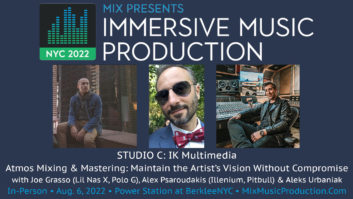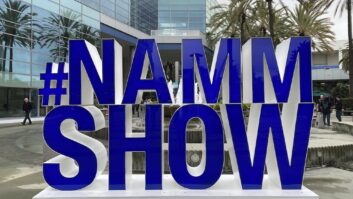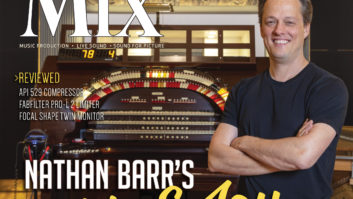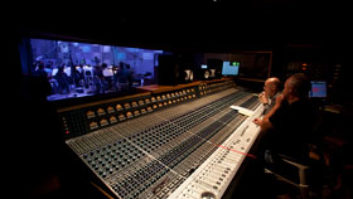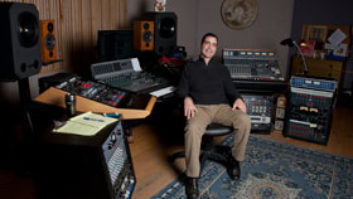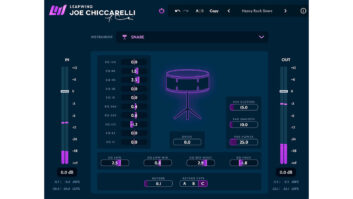On a Saturday afternoon in late June, Vintage King, celebrating its 25th anniversary this year, hosted a “Gear and Beer” Summit in Nashville on the final day of Summer NAMM. There were sales and promotions and bands, with big fun all around. And in keeping with the retailer’s commitment to artists and engineers, there were a number of opportunities to interact with the best talent in town.
One of the highlights was an afternoon chat between Blackbird Studio owner and stellar studio and live engineer John McBride and one of the finest producer/engineers on the planet, Joe Chiccarelli.
Following is an edited transcript of their talk.
John McBride: I love Joe Chiccarelli. He’s done a lot of work at Blackbird over the years, and it’s the kind of work that you are very, very proud as a studio to hang your hat on. But mostly he’s just a great person. What do you want to talk about today, Joe?
Joe Chiccarelli: I was thinking, I started coming down to Nashville in the days before Whole Foods. The days when a vegetarian like myself had a hard time in this town. I remember ordering salads all the time and asking them to hold the bacon, and it would always show up with bacon.
McBride: Of course. I got him some fried lettuce one night.
Chiccarelli: Of course. So it’s great to see this city grow and change. And Blackbird indeed has been home to me for many years, some of my favorite records that I’ve made. I’ve been fortunate to work in Studio D and A—White Stripes, Raconteurs, My Morning Jacket, Manchester Orchestra, Doug Seegers. So many things. But for me, it’s always about the magic and the inspiration.
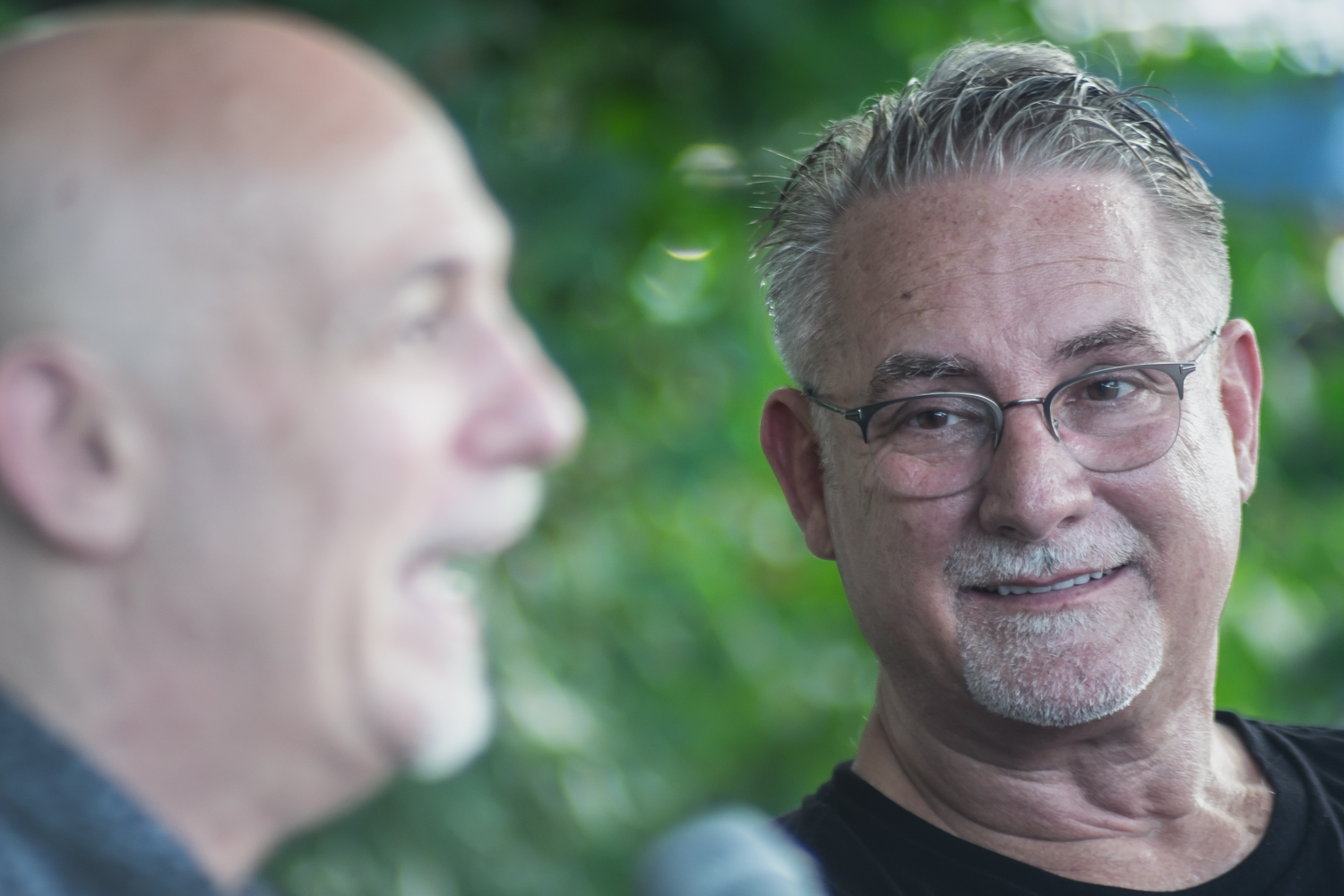
You know, one of the first things I did at Blackbird was with Jack White. We went in to do a live-to-8-track version of a Hank Williams song that Jack actually co-wrote with Hank via a resurrected manuscript that they found. We did it in Studio D with everybody in a circle around a few microphones, and everybody was so inspired by the sound of the room, the quality of the playbacks, that the performance—I still listen to that track, it’s on my showreel, if you will. And its stunning because of the performance. We can get caught up with all these technical details, but in the end it’s about the artist and the performance and the song. And you start and end with that.
McBride: I consider myself an engineer but not a producer. My definition of a producer is someone that knows music, that plays music, that reads music, that can possibly do arrangements, who can speak to musicians on their terms. How did you get that talent, Joe?
Chiccarelli: I think by watching a lot of other producers. I was pretty fortunate in that when I started, you kind of came up through the studio system. You worked as an assistant engineer or perhaps a runner at the studio. I started at Cherokee Studios in L.A., and it was the happening place in L.A. then. They had Trident A Range consoles, which were these very unique British consoles, so all the UK producers when they came to L.A. to record, they’d always come to Cherokee. I was fortunate. One day I’d be working with George Martin, the next day I’d be working on a Genesis album, the next day it would be the Bee Gees. The talent that came through that studio … and every day or every week it was a different artist and a different producer, a different engineer.
Roy Thomas Baker, I probably did three or four albums with Roy, who did all the Queen and the Cars and so many great records. I got to watch other people and was just really a sponge. When I was there, Frank Zappa booked into the studio and the word was that Frank was a workaholic and that it was going to be long hours, so of course being the new guy, it was like, “Okay, put Chiccarelli on the session.” What happened was his engineer couldn’t make the session at the very last minute. Literally, when we were in the studio he got the call, so Frank said, “Look, you’re it, you’re engineering for me.”
Luckily I was not a Frank Zappa fan—I mean, I knew of his music and knew of him and wasn’t intimidated or uncomfortable in any way, so it was just Frank and I working together doing vocals and guitar solos. I was 20 years old, I was cocky and I had no problem saying, “Hey, Frank, I think you’re out of tune there,” or, “Frank, I think you’re sharpening that note a little bit.” I think he actually really loved me for being honest with him, and after three days of working together, he said, “Look, we got to finish this record, they’re all booked up here at the studio, do you want to come with me and finish the album?” And that led to about six other albums of engineering for Frank Zappa, so in nine months I went from an assistant engineer to engineering Frank’s “Shake Your Booty” album, which was his first commercially successful album. I turned 21 when I was working on “Joe’s Garage” for him.
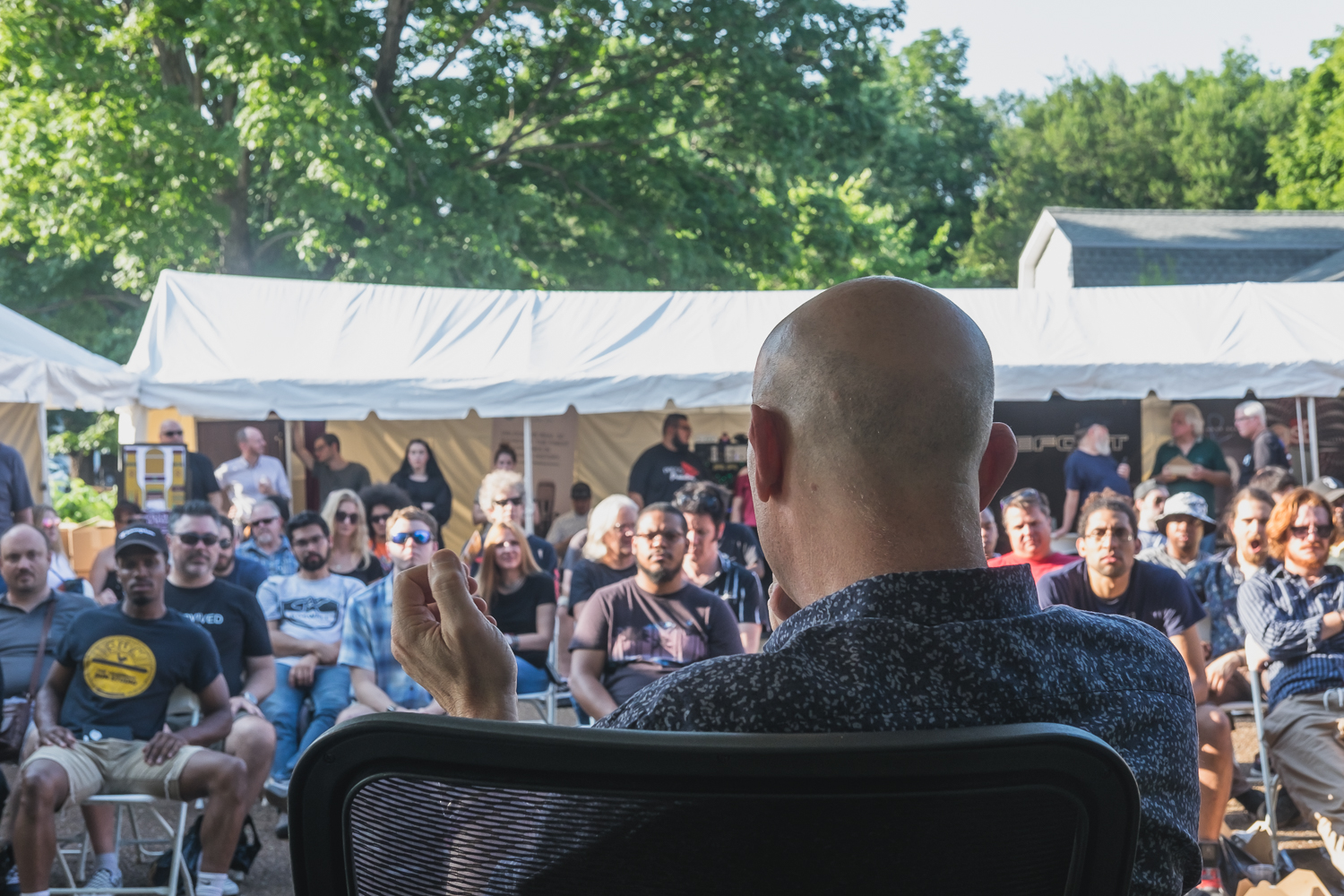
McBride: ”Joe’s Garage” was my favorite all-time Zappa record, no doubt about it. And it sounds great by the way.
Chiccarelli: You know why it sounds great? I had no clue what I was doing, I swear to God. It was the second album that I ever engineered, and all I did was try everything that I saw every other engineer that came through Cherokee do.
McBride: Owning a studio, I had the advantage of being able to walk in on a session with Phil Ramone or George Massenburg or Peter Asher or whoever. I’d hear it and I’d go, “Wow.” I’d go to the assistant and say, “Tell me what that mic chain is ’cause I got to take a look at this.” While a huge part of sound is what’s behind the mic. the proper mic technique can bring out the best in anyone, and when you combine great mic technique with a great player, that’s where 1 and 1 is 3 and we get the greatness.
Mix Interview: Producer/Engineer Joe Chiccarelli, by Blair Jackson, March 1, 2012
Chiccarelli: You were talking mic technique and I was just thinking of the White Stripes sessions. First of all, the combination of Meg and Jack is just unequaled; they’re just perfect for each other. And when Jack called me to do the White Stripes, I really thought, “Wow, this my shot to do the classic ’70s Glyn Johns rock record, where it’s two instruments and they take up the whole record. This is going to be great. I’m going to use all of these really organic techniques and really honest recording.” I’ll never forget that first day of going in there, tracking, and I got this nice organic drum sound and this nice guitar sound with a 67 a few feet off the amplifier thinking. “That’s how Glyn Johns did it.” And within about a half-hour, it was the most boring thing I’ve ever heard in my life because I realized that this worked in 1971 but now we’re in an era of hip hop records—more low end, more pressed, more in-your-face sound, and I had to do something where these two instruments took up every single frequency.
I remember running to the equipment closet with Lowell and dragging out a dbx Boom Box and every compressor imaginable. Meg is a great drummer in that she doesn’t hit her cymbals loud, she digs into her toms, digs into her kick, but her snare is really not that loud. I remember kind of freaking out, like, “What am I going to do? How can I make a rock record without an aggressive snare?” You have to understand, this is Jack White before Pro Tools, so this was all to 16-track analog tape. There’s no plug-ins, there’s no sampling, there’s no nothing. So I was thinking, “I got to amplify her snare some way.” I remember dragging out this old Watkins Westminster amp that had a particular honky midrange to it and got a Shure Bullet Microphone and I gaffer taped it underneath her snare drum and plugged it into the amp. Sat the amplifier right behind her drum stool so every time she hit the snare it went through the guitar amp and then through every drum mic, every room mic, and just splattered the room with snare drum; and it made her sound way more aggressive than she was. Obviously, her kick and everything else was fine, but I needed to somehow make her snare drum busy. So it’s a case where technique is really driven by the product and the sound you’re after and the artist. Look, when you work with Jack and Meg, you’re 20 steps ahead of the game to start with.
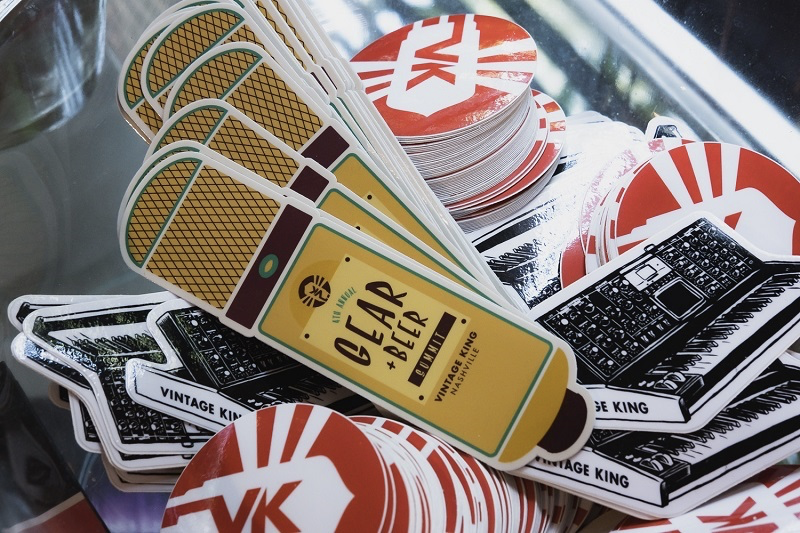
McBride: We’re gonna play a song here in a minute. A Morrissey track, I believe.
Chiccarelli: A song called “Spent the Day in Bed.” I’ve been fortunate to work on his last two records, and you know, he’s one of those great artists where he comes up to the microphone and man, he delivers. What he brings melodically is unbelievable, and he’ll do this crazy thing where he’ll sing a certain melody for the chorus but the next time when the chorus comes up, he might sing a different melody, but when the bridge comes up he might sing the chorus melody over that. Your inclination is to get on the talkback and go, “You know, Moss, I think your singing, uhhh.” But no, it’s deliberate. The interesting thing is that this is a guy that really grew up in the ’80s listening to the Clash and punk rock. His favorite band is the Ramones. But at the same time he studied Sinatra and every ’40s, ’50s, ’60s crooner there is. So it’s the craziest combination of a singer doing these sort of European Latin melodies but with his punk rock attitude.
Morrissey’s Flair for the Dramatic: “World Peace Is None of Your Business,” by Barbara Schultz, Aug. 1, 2014
He’ll come in at 11 o’clock in the morning, and we’ll sit there find the right key for the song, find the right tempo, then he’ll go out and he’ll deliver a guide vocal in one or two takes, and the guide vocals are so strong and so indicative of what the song is going to be like. He’ll dig in when it wants to be big and important, and he’ll chill out and be more behind the beat when he wants it to be more relaxed. So everything you need to know about where to take a song is in his guide vocal performance. I would then work the arrangement all around his vocal.
McBride: What percentage of the mixes you do nowadays are in the box versus on a desk?
Chiccarelli: I will say sadly it’s all dictated by budget. If the money is there and the artist is present in the room, we’ll mix it on the console. The thing I love is the interaction with the artist.
McBride: I still feel like the stereo bus on the digital side of the world doesn’t work as well as, or like an analog bus,
Chiccarelli: Even when I’m all digital I’m using an analog summing network. I have a Burl summing box and everything goes thought that, and then it actually goes into my Burl Bomber—that’s my converter. Since 2000 everything I’ve done is at 24/96 and above; that’s my lowest resolution of anything I do. Most of the time its 32/96; I’m a big believer in hi-res. I think it makes mixing easier—there’s more space between the sound, it’s just more transparent, it’s just easier on the ears.
McBride: What else? Do you have go-to mics and go-to setups?
Chiccarelli: Yeah, we all have our things, but my drum setups change from project to project sometimes it’s just a mono 47 over it sometimes it’s a lo-fi mic, sometimes it’s C12s in stereo. The one thing I always do is I put up half a dozen or so room mics—some far, some close—and I’ll blend them and change them up for every tune because one song wants to be dry, one song wants distance. So I give myself a bunch of room mic options. But yes, I mean I love D12s on kick drums, I still use old-school 421s on toms.
Want more stories like this? Subscribe to our newsletter and get it delivered right to your inbox.
This is going to be a shameless plug, but for the last five years I’ve been trying to re-create one of my favorite microphones of all time, which is a Sony C 37a. It’s a tube microphone made in the 1950s. I’ve been working with the guys at Tonelux to rebuild this mic and I think that we’re finally very, very close. We actually got the original transformers from Japan. The Sony microphone is something that I use for acoustic guitars, for drum overheads, for vocals, and it’s got a couple of interesting characteristics: where a lot of modern microphones have peaks in the presence at 3k or 5k this actually has a little dip at 3k or 5k, but then it rises at 15k, 12-15k, so it’s soft at the upper midrange which makes it good for acoustic guitar and cymbals. And it does another thing where it’s a very basic simple tube microphone circuit, and the circuit in the transformer compresses in a really great way so it adds this distortion. Singers love it. It was Frank Sinatra’s favorite vocal mic because it just self-limited him. He could work the mic and knew were to dig in and let the microphone compress and do the work for him. So it’s a very, very unique microphone and hopefully it will be available at Vintage King in the next six months, so we’ll see.
